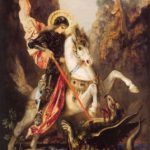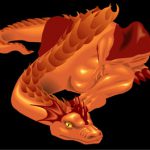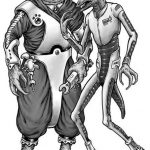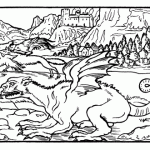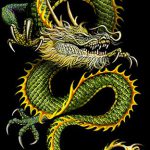The English word "dragon" derives from Greek δράκων (drákōn), "dragon, serpent of huge size, water-snake", which probably comes from the verb δρακεῖν (drakeîn) "to see clearly".
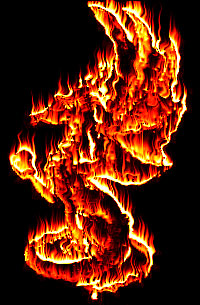
In Ancient Greece the first mention of a "dragon" is derived from the Iliad where Agamemnon is described as having a blue dragon motif on his sword belt and a three-headed dragon emblem on his breast plate; however, the Greek word used (δράκων drákōn, genitive δράκοντοϛ drákontos) could also mean "snake".
δράκων drákōn is a form of the aorist participle active of Greek δέρκομαι dérkomai = "I see", derkeîn = "to see", and originally likely meant "that which sees", or "that which flashes or gleams" (perhaps referring to reflective scales).
The Complete Oxford Dictionary
dragon 1. A huge serpent or snake; a python. Obs. (exc. in etymol. use).
2. a. A mythical monster, represented as a huge and terrible reptile, usually combining ophidian and crocodilian structure, with strong claws, like a beast or bird of prey, and a scaly skin; it is generally represented with wings, and sometimes as breathing out fire. The heraldic dragon combines reptillian and mammalian form with the addition of wings. b. Hence frequent allusions to ancient and medieval tales of dragons, as those which watchfully guarded the Gardens of the Hesperides, those which drew the chariot of Cynthia or the moon, those fought and slain by Beowulf, St. George, and other champions. c. like a dragon: fiercely, violently.
3. In the Bible versions reproducing draco of the Vulgate and Spakwv of the Septuagint, where the Hebrew has (a) tannin a great sea- or water-monster, a whale, shark, or crocodile, also a large serpent; or (b) tan a desert mammalian animal, now understood to be a jackal, and so rendered in the Revised Version.
4. a. An appellation of Satan, the ‘Old Serpent’. b. transf. A devilish person; a ‘fiend’. c. An evil power embodied. rare.
5. An appellation of Death. arch.
6. A fierce violent person; esp. a fiercely or agressively watchful woman; a duenna.
7. a. A representation or figure of the mythical creature. b. An ensign or standard, having the figure of a dragon. Obs. c. dragon china, a kind of porcelain decorated with designs of dragons. d. to chase the dragon (slang): to take heroin by inhalation (see quot. 1961).
8. Astron. a. A northern constellation, Draco. b. The part of the moon’s path which lies south of the ecliptic: see DRAGON’S HEAD, TAIL. Obs. c. Applied to a shooting star with a luminous train. Obs. Cf. DRAKE1 2.
9. A paper kite. [Ger. drache.] Sc.
10. a. An early fire-arm; = DRAGOON 1. Obs. b. A soldier armed with this; = DRAGOON 2. Obs. c. A very powerful armoured tractor.
11. Zool. A lizard of the genus Draco, having on each flank a broad wing-like membrane, which enables it to leap some distance in the air.
12. Ichthyol. (Also dragon-fish.) a. =DRAGONET 2. b. The ANGLER, Lophius (obs.).
13. A fancy variety of pigeon; = DRAGOON sb. 3.
14. (Also green dragon.) The plant Dracunculus vulgaris (formerly Arum Dracunculus); =DRAGONS; DRAGONWORT. Also applied to species of Dracontium.
15. A disease of the eye of the horse; see quots.
16. (Also dragon cane): see quot.
17. slang. A sovereign: from the device of St. George and the Dragon.
18. attrib. or as adj. Of or as of a dragon, of the nature of a dragon; dragon-like, dragonish. dragon boat = DRAKE1 5.
19. General Combs.: a. attributive, as dragon-bought, -coil, -face, -feet, -hame (covering), -hole, -killer, -kind, -legend, -mail, -race, -scale, -seed, tooth (see 21 b), -whelp, -womb,; b. similative, as dragon-green adj.; c. instrumental, as dragon guarded, -ridden, -wardered adjs.; d. parasynthetic, as dragon-eyed, -mouthed, -penned, -winged, adjs.; also dragon-like adj and adv.

